1998 CHEVROLET CAVALIER engine overheat
[x] Cancel search: engine overheatPage 256 of 400
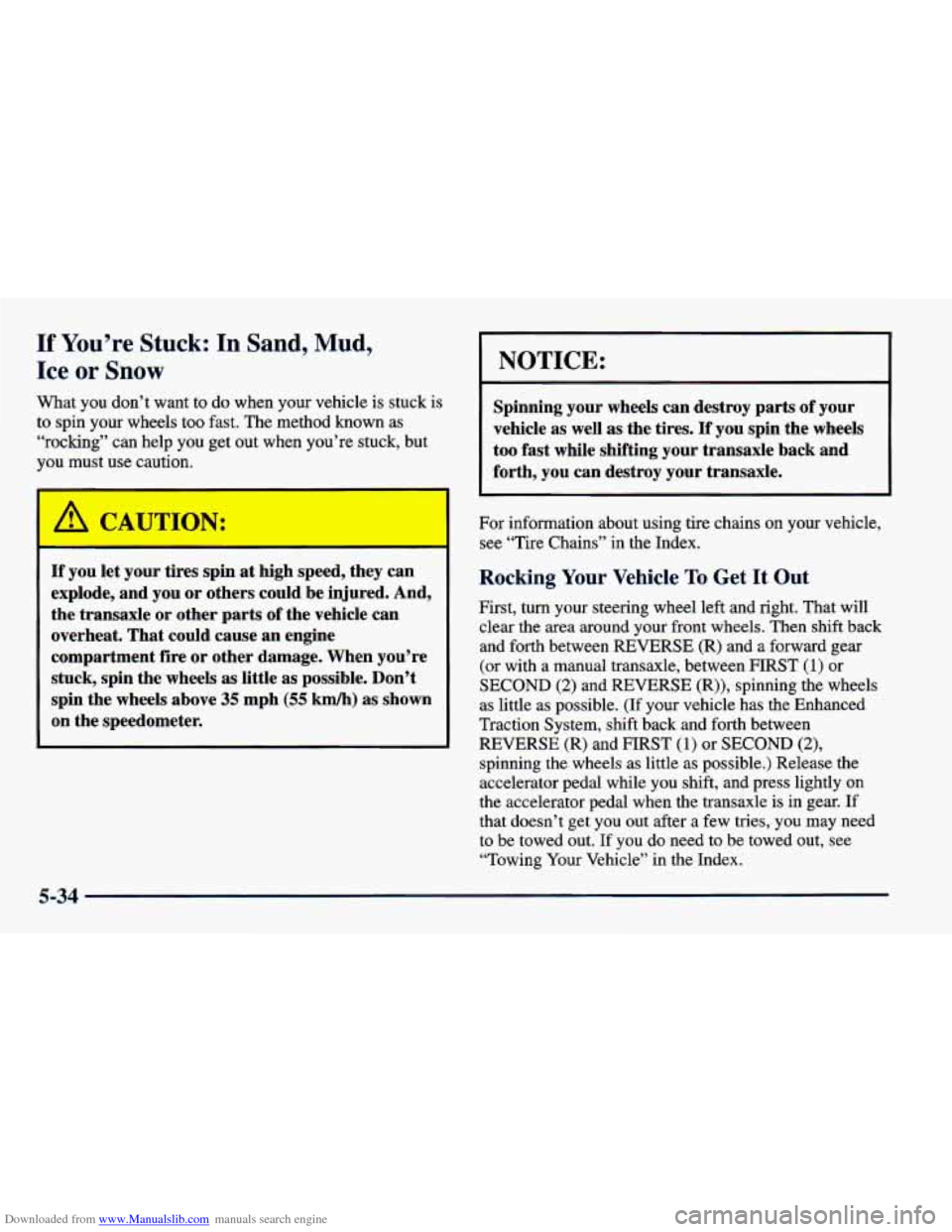
Downloaded from www.Manualslib.com manuals search engine If You’re Stuck: In Sand, Mud,
Ice or Snow
What you don’t want to do when your vehicle is stuck is
to spin your wheels too fast. The method known as
“rocking” can help you get out when you’re stuck, but
you must use caution.
I
NOTICE:
Spinning your wheels can destroy parts of your
vehicle as well
as the tires. If you spin the wheels
too
fast while shifting your transaxle back and
forth, you can destrov vour transaxle.
If you let your tires spin at high speed, they can
explode, and
you or others could be injured. And,
the transaxle
or other parts of the vehicle can
overheat. That could cause an engine
compartment fire
or other damage. When you’re
stuck, spin the wheels as little as possible. Don’t
spin the wheels above
35 mph (55 km/h) as shown
on the speedometer.
For information about using tire chains on your vekfe,
see “Tire Chains” in the Index.
Rocking Your Vehicle To Get It Out
First, turn your steering wheel left and right. That will
clear the area around your front wheels. Then shift back and forth between REVERSE (R) and a forward gear
(or with a manual transaxle, between FIRST
(1) or
SECOND
(2) and REVERSE (R)), spinning the wheels
as little as possible.
(If your vehicle has the Enhanced
Traction System, shift back and forth between
REVERSE (R) and FIRST
(1) or SECOND (2),
spinning the wheels as little as possible.) Release the
accelerator pedal while you shift, and press lightly on
the accelerator pedal when the transaxle is in gear. If that doesn’t get
you out after a few tries, you may need
to be towed out. If you do need to be towed out, see
“Towing Your Vehicle” in the Index.
5-34
Page 283 of 400
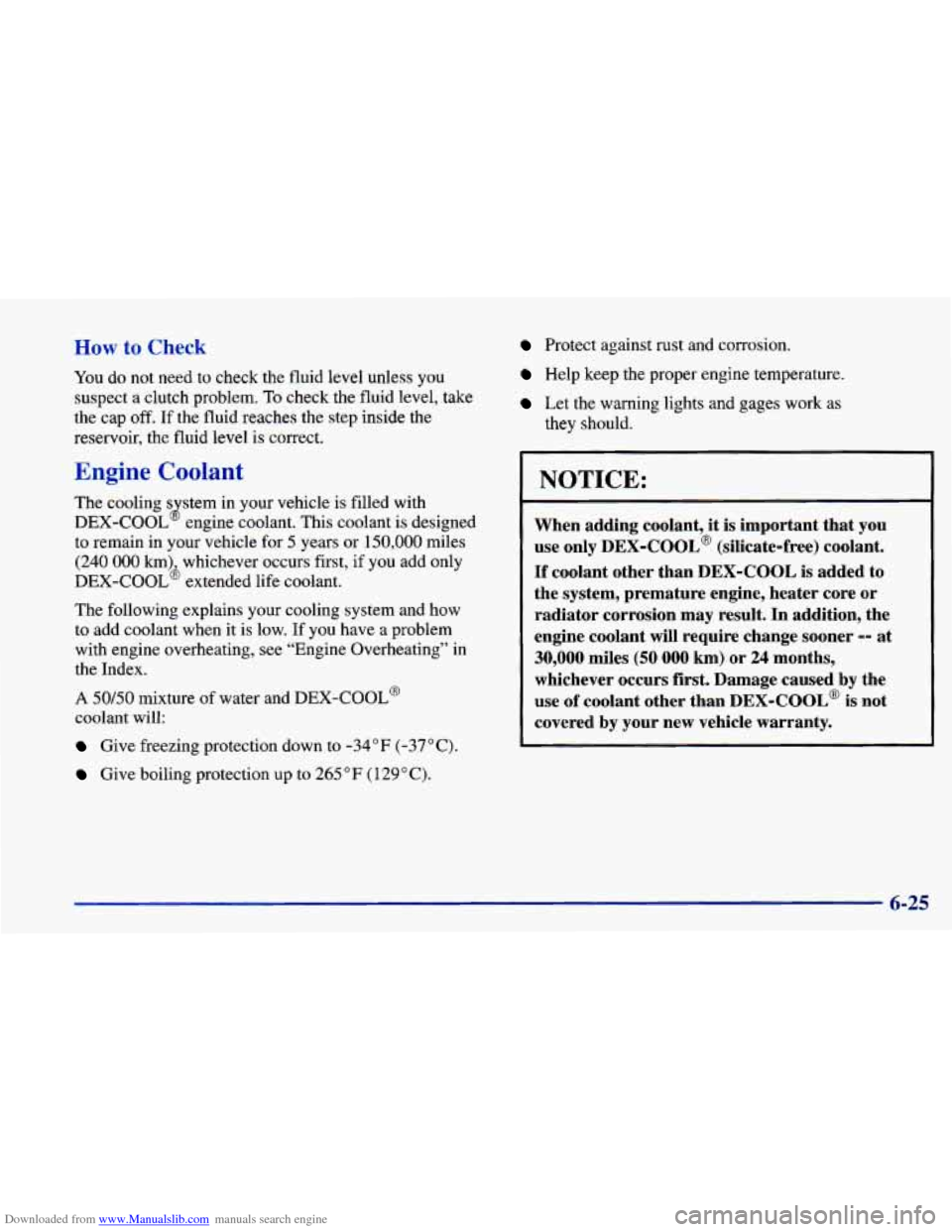
Downloaded from www.Manualslib.com manuals search engine How to Check
You do not need to check the fluid level unless you
suspect a clutch problem.
To check the fluid level, take
the cap
off. If the fluid reaches the step inside the
reservoir, the fluid level is correct.
Engine Coolant
The cooling s stem in your vehicle is filled with
DEX-COOL
8 engine coolant. This coolant is designed
to remain in your vehicle for
5 years or 150,000 miles
(240 000 km) whichever occurs first, if you add only
DEX-COOL’ extended life coolant.
The following explains your cooling system and how
to add coolant when it is low. If you have a problem
with engine overheating, see “Engine Overheating” in
the Index.
A 50/50 mixture of water and DEX-COOL@
coolant will:
Give freezing protection down to -34°F (-37°C).
Give boiling protection up to 265 “F (129°C).
Protect against rust and corrosion.
Help keep the proper engine temperature.
Let the warning lights and gages work as
they should.
NOTICE:
When adding coolant, it is important that you
use only
DEX-COOL@ (silicate-free) coolant.
If coolant other than DEX-COOL is added to
the system, premature engine, heater core or
radiator corrosion may result. In addition, the
engine coolant will require change sooner
-- at
30,000 miles (50 000 km) or 24 months,
whichever occurs first. Damage caused by the
use of coolant other than DEX-COOL@ is not
covered by your new vehicle warranty.
6-25
Page 284 of 400
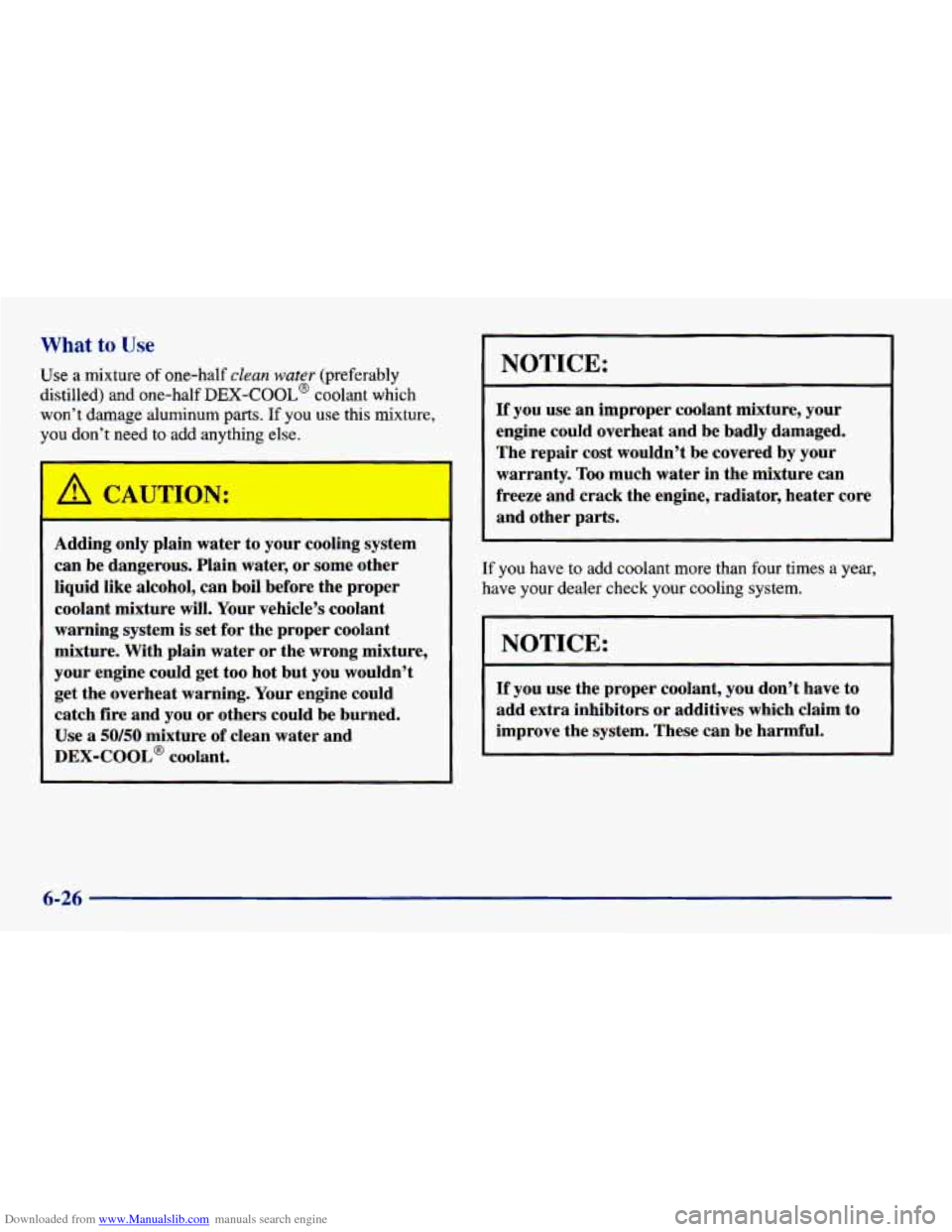
Downloaded from www.Manualslib.com manuals search engine What to Use
Use a mixture of one-half clean water (preferably
distilled) and one-half
DEX-COOL@ coolant which
won’t damage aluminum parts.
If you use this mixture,
you don’t need to add anything else.
Adding only plain water to your cooling system
can be dangerous. Plain water,
or some other
liquid like alcohol, can boil before the proper
coolant mixture will. Your vehicle’s coolant
warning system is set for the proper coolant
mixture. With plain water or the wrong mixture,
your engine could get too hot but you wouldn’t
get the overheat warning. Your engine could
catch fire and you or others could be burned.
Use
a 50/50 mixture of clean water and
DEX-COOL@ coolant.
NOTICE:
If you use an improper coolant mixture, your
engine could overheat and be badly damaged.
The repair cost wouldn’t be covered by your
warranty.
Too much water in the mixture can
freeze and crack the engine, radiator, heater core
and other parts.
If you have to add coolant more than four times a year,
have your dealer check your cooling system.
NOTICE:
If you use the proper coolant, you don’t have to
add extra inhibitors or additives which claim to
improve the system. These can be harmful.
6-26
Page 286 of 400
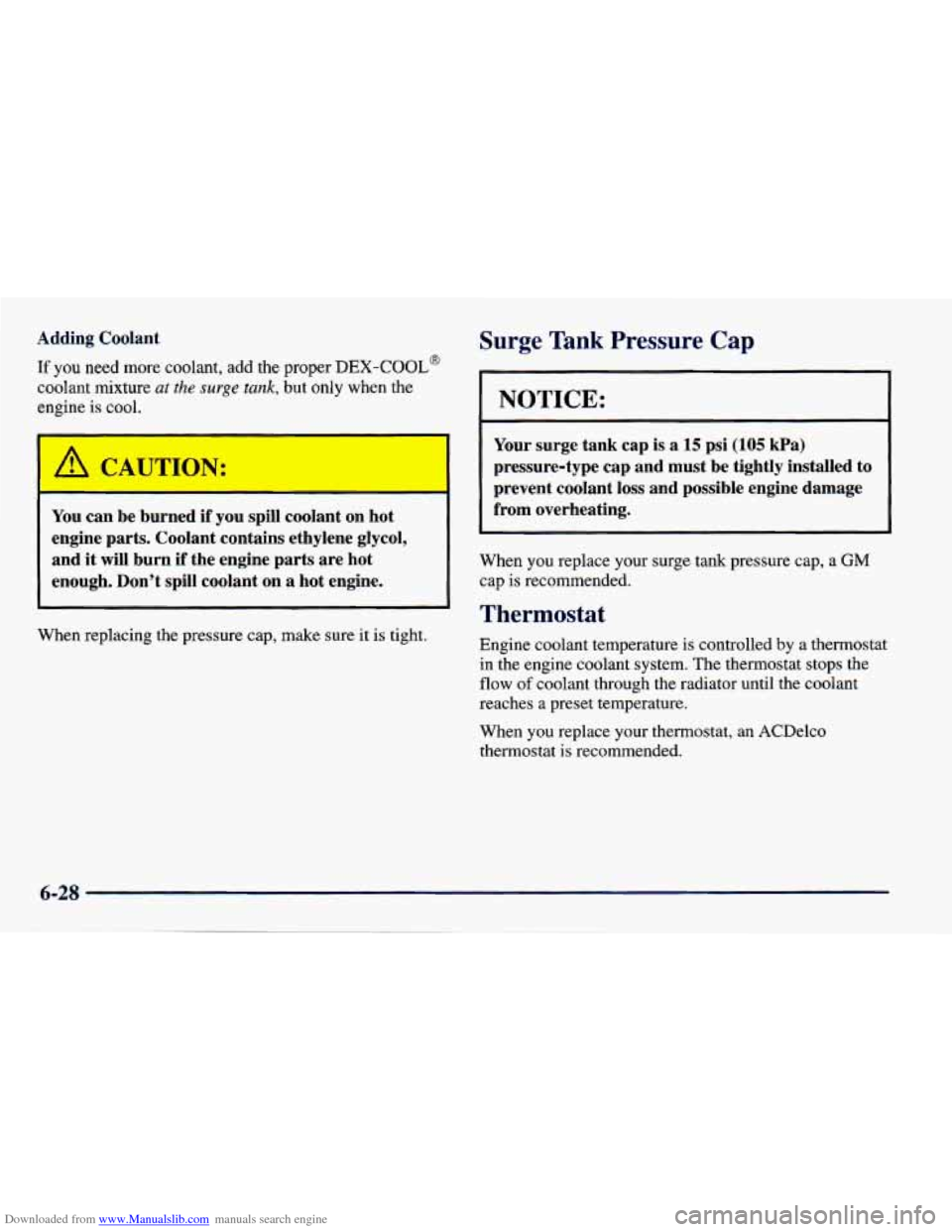
Downloaded from www.Manualslib.com manuals search engine Adding Coolant
If you need more coolant, add the proper DEX-COOL@
coolant mixture at the surge tank, but only when the
engine is cool.
I’
You can be burned if you spill coolant on hot
engine parts. Coolant contains ethylene glycol,
and
it will burn if the engine parts are hot
enough. Don’t spill coolant on a hot engine.
When replacing the pressure cap, make sure it is tight.
Surge Tank Pressure Cap
NOTICE:
Your surge tank cap is a 15 psi (105 kPa)
pressure-type cap and must be tightly installed to
prevent coolant
loss and possible engine damage
from overheating.
When you replace your surge tank pressure cap, a GM
cap is recommended.
Thermostat
Engine coolant temperature is controlled by a thermostat
in the engine coolant system. The thermostat stops the
flow of coolant through the radiator until the coolant
reaches
a preset temperature.
When
you replace your thermostat, an ACDelco
thermostat is recommended.
Page 298 of 400
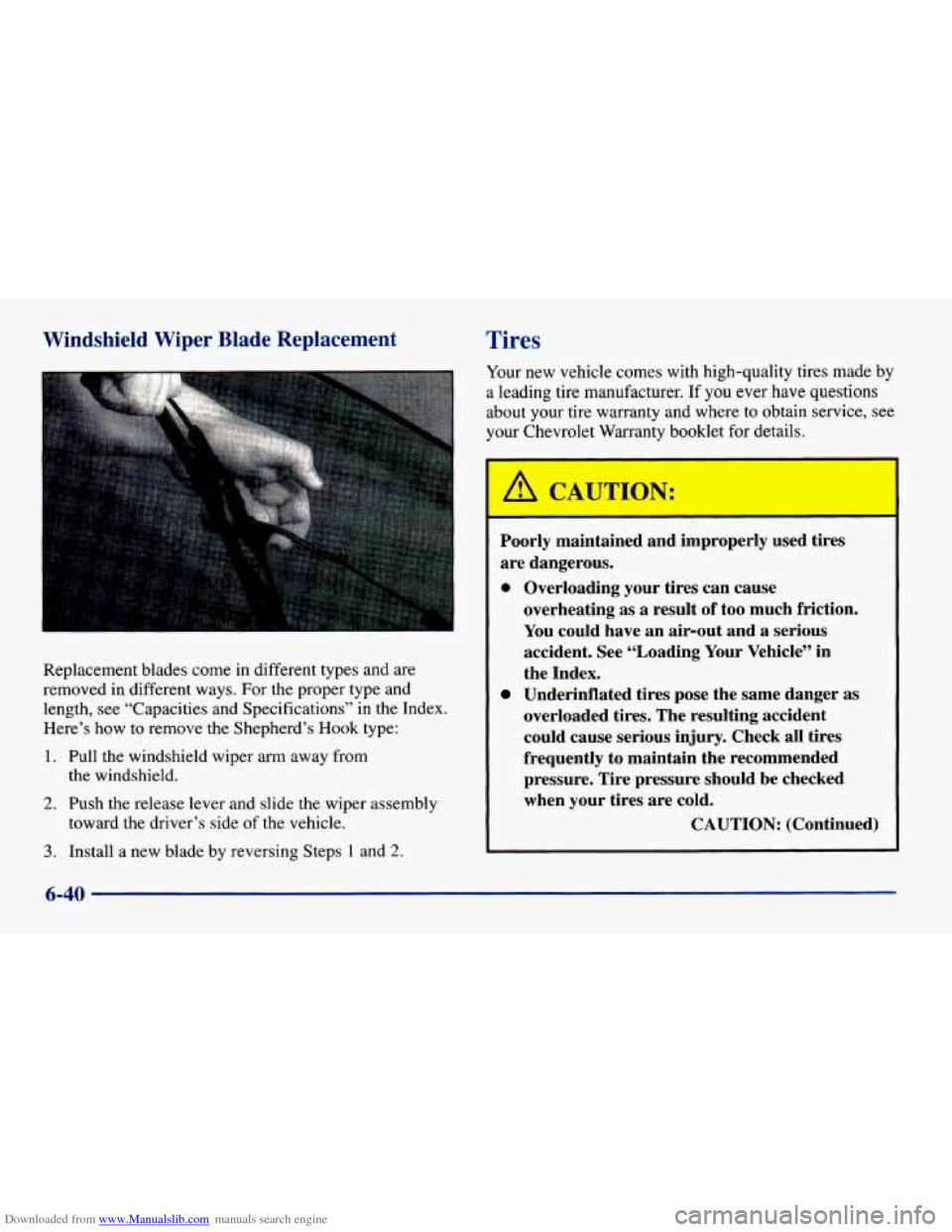
Downloaded from www.Manualslib.com manuals search engine Windshield Wiper Blade Replacement Tires
Your new vehicle comes with high-quality tires made by
a leading tire manufacturer. If you ever have questions
about your tire warranty and where to obtain service, see
your Chevrolet Warranty booklet for details.
Replacement blades come in different types and are
removed in different ways. For the proper type and
length, see “Capacities and Specifications” in the Index.
Here’s how to remove the Shepherd’s
Hook type:
1. Pull the windshield wiper arm away from
2. Push the release lever and slide the wiper assembly
the
windshield.
toward the driver’s side
of the vehicle.
3. Install a new blade by reversing Steps 1 and 2.
Poorly maintained and improperly used tires
are dangerous.
0 Overloading your tires can cause
overheating as a result
of too much friction.
You could have an air-out and a serious
accident. See (‘Loading Your Vehicle” in
the Index.
Underinflated tires pose the same danger as
overloaded tires. The resulting accident
could cause serious injury. Check all tires
frequently to maintain the recommended
pressure. Tire pressure should be checked
when your tires are cold.
CAUTION: (Continued)
6-40
Page 316 of 400
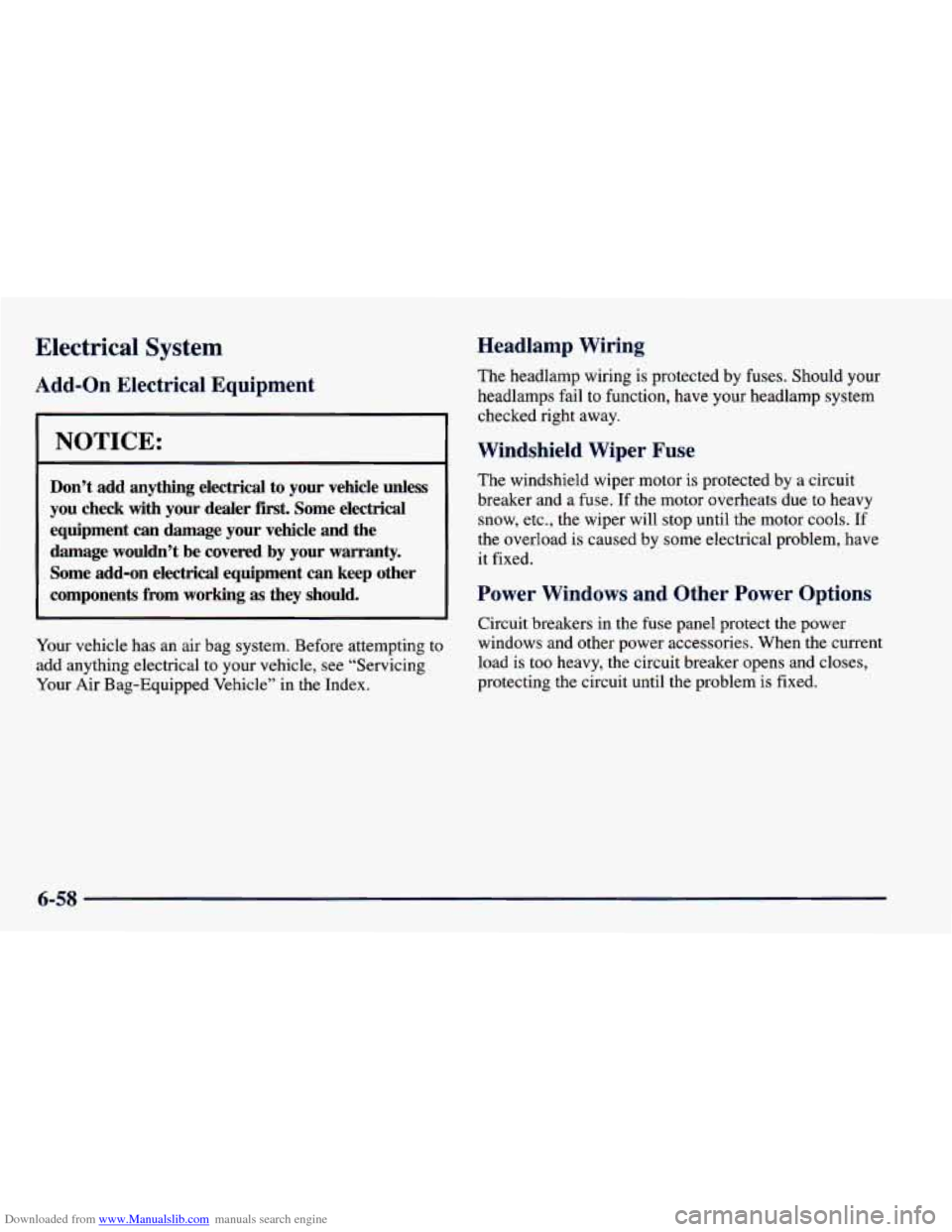
Downloaded from www.Manualslib.com manuals search engine Electrical System
Add-on Electrical Equipment
NOTICE:
Don’t add anything electrical to your vehicle unless
you check
with your dealer first. Some electrical
equipment can damage your vehicle and the
damage wouldn’t be covered
by your warranty.
Some add-on electrical equipment
can keep other
components
from working as they should.
Your vehicle has an air bag system. Before attempting to
add anything electrical to your vehicle, see “Servicing
Your Air Bag-Equipped Vehicle” in the Index.
Headlamp Wiring
The headlamp wiring is protected by fuses. Should your
headlamps fail
to function, have your headlamp system
checked right away.
Windshield Wiper Fuse
The windshield wiper motor is protected by a circuit
breaker and a fuse. If the motor overheats due
to heavy
snow, etc., the wiper will stop until the motor cools. If
the overload is caused by some electrical problem, have
it fixed.
Power Windows and Other Power Options
Circuit breakers in the fuse panel protect the power
windows and other power accessories. When the current
load is too heavy, the circuit breaker opens and closes,
protecting the circuit until the problem is fixed.
6-58
Page 386 of 400
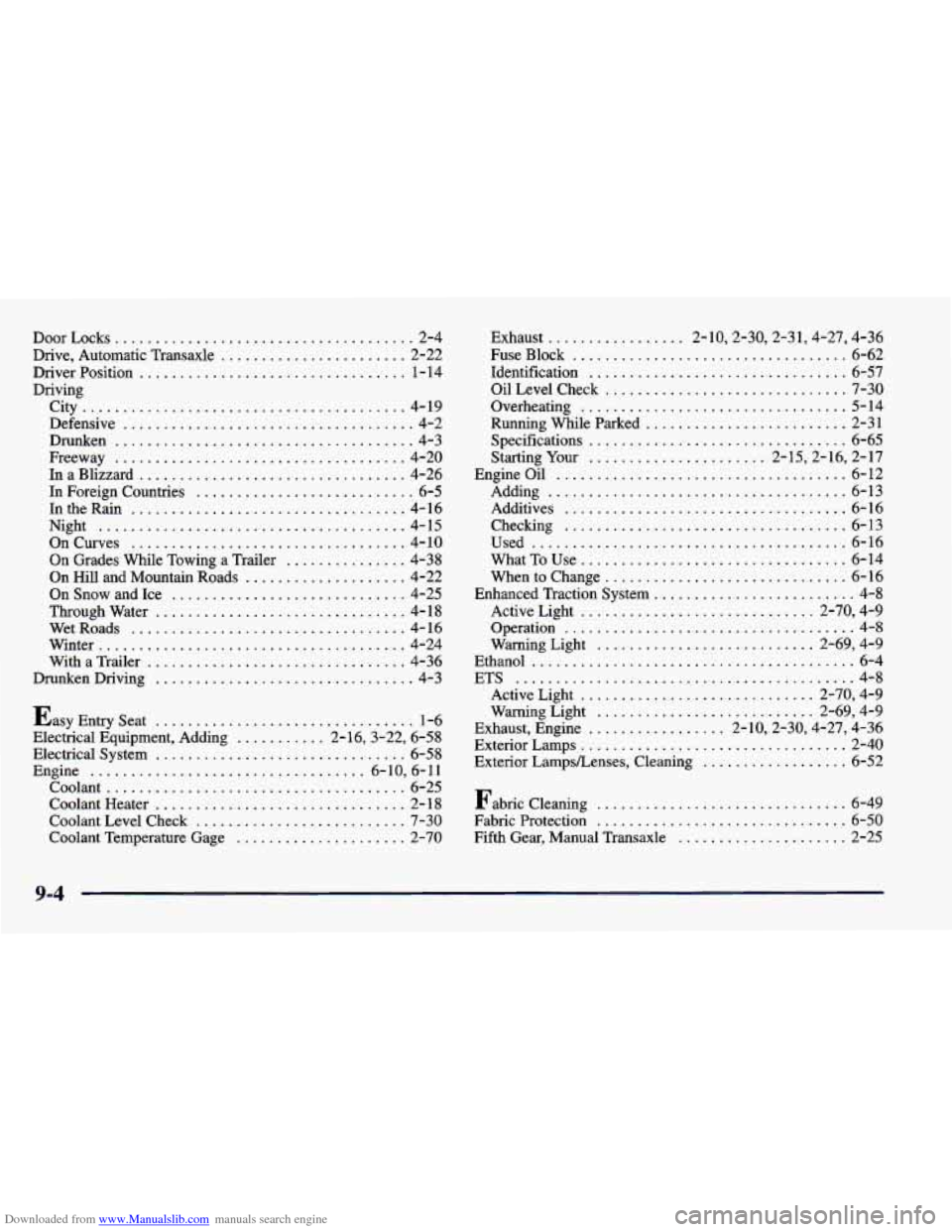
Downloaded from www.Manualslib.com manuals search engine Door Locks ..................................... 2-4
Drive. Automatic Transaxle
....................... 2-22
Driver Position
................................. 1 - 14
Driving City
........................................ 4-19
Defensive
.................................... 4-2
Drunken
..................................... 4-3
Freeway
.................................... 4-20
In a Blizzard
................................. 4-26
In Foreign Countries
........................... 6-5
In
the Rain .................................. 4-16
Night
...................................... 4-15
On Curves
.................................. 4-10
On Grades While Towing a Trailer
............... 4-38
On Hill and Mountain Roads
.................... 4-22
On Snow and Ice
............................. 4-25
Through Water
............................... 4- 18
WetRoads
.................................. 4-16
Winter
...................................... 4-24
With a Trailer
................................ 4-36
Drunken Driving
................................ 4-3
Easy Entry Seat
................................ 1-6
Electrical Equipment. Adding
........... 2.16.3.22. 6.58
Electrical System
............................... 6-58
Engine
.................................. 6.10. 6.11
Coolant
..................................... 6-25
Coolant Heater
............................... 2- 18
Coolant Level Check .......................... 7-30
Coolant Temperature Gage
..................... 2-70 Exhaust
................. 2.10.2.30.2.31.4.27. 4.36
Fuse Block
.................................. 6-62
Identification
................................ 6-57
OilLevelCheck
.............................. 7-30
Overheating
................................. 5-14
Running While Parked
......................... 2-31
Specifications
................................ 6-65
Starting Your
...................... 2.15.2.16. 2.17
Engineoil
.................................... 6-12
Adding
..................................... 6-13
Additives
................................... 6-16
Checking
................................... 6-13
Used
....................................... 6-16
What To Use
................................. 6-14
Whentochange
.............................. 6-16
Enhanced Traction System
......................... 4-8
Active Light
............................. 2.70. 4.9
Operation
.................................... 4-8
Ethanol
........................................ 6-4
ETS
.......................................... 4-8
Active Light
............................. 2.70. 4.9
Warning Light
........................... 2.69. 4.9
Exhaust. Engine
................. 2.10.2.30.4.27. 4.36
Exterior Lamps
................................. 2-40
Exterior LampsLenses. Cleaning
.................. 6-52
Warning Light
........................... 2.69. 4.9
Fabric Cleaning
............................... 6-49
Fabric Protection
............................... 6-50
Fifth Gear. Manual Transaxle ..................... 2-25
9-4
Page 390 of 400
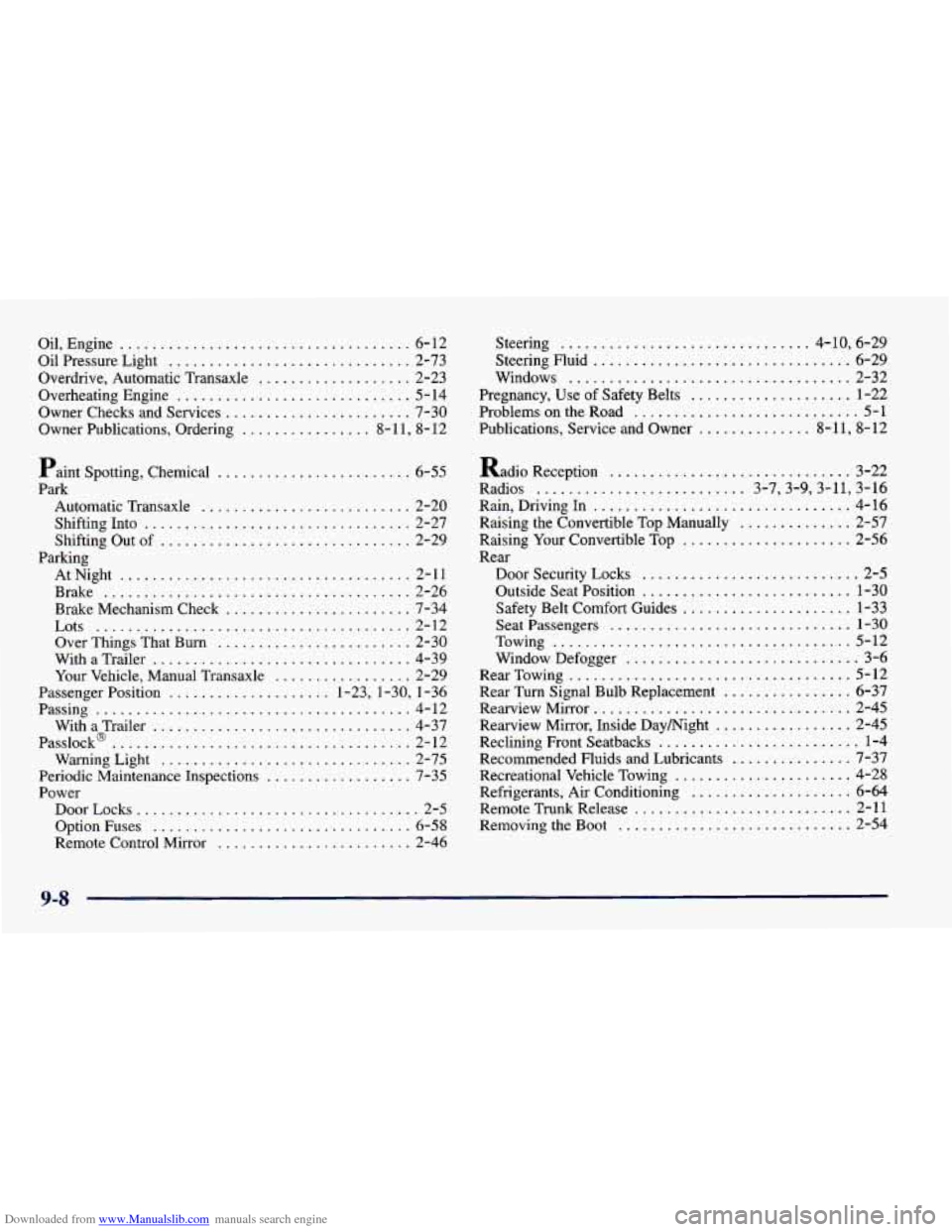
Downloaded from www.Manualslib.com manuals search engine Oil. Engine .................................... 6-12
Oil Pressure Light
.............................. 2-73
Overdrive, Automatic Transaxle
................... 2-23
Overheating Engine
............................. 5- 14
Owner Checks and Services ....................... 7-30
Owner Publications. Ordering
................ 8-1 1, 8-12
Paint Spotting. Chemical
........................ 6-55
Park
Automatic Transaxle
.......................... 2-20
Shifting Into
................................. 2-27
Shifting Out of
............................... 2-29
Parking AtNight
.................................... 2-11
Brake
...................................... 2-26
Brake Mechanism Check
....................... 7-34
Lots
....................................... 2- 12
Over Things That Burn
........................ 2-30
With a Trailer
................................ 4-39
Your Vehicle, Manual Transaxle
................. 2-29
Passenger Position
.................... 1-23, 1-30. 1-36
With
a Trailer ................................ 4-37
Passlock@
..................................... 2-12
Warning Light
............................... 2-75
Periodic Maintenance Inspections
.................. 7-35
Power
DoorLocks
................................... 2-5
Option Fuses ................................ 6-58
Remote Control Mirror ........................ 2-46
Passing
....................................... 4-12 Steering
............................... 4- 10. 6.29
Steering Fluid
................................ 6-29
Windows
................................... 2-32
Pregnancy, Use of Safety Belts
.................... 1-22
Problems on the Road
............................ 5-1
Publications, Service and Owner
.............. 8- 11, 8- 12
Radio Reception .............................. 3-22
Radios
.......................... 3.7.3.9.3.11. 3.16
Rain. Driving In ................................ 4-16
Raising the Convertible Top Manually
.............. 2-57
Raising Your Convertible Top
..................... 2-56
Rear Door Security Locks
........................... 2-5
Outside Seat Position
.......................... 1-30
Safety Belt Comfort Guides
..................... 1-33
Seatpassengers .............................. 1-30
Towing
..................................... 5-12
Window Defogger
............................. 3-6
RearTowing
................................... 5-12
Rear Turn Signal Bulb Replacement
................ 6-37
Rearview Mirror ................................ 2-45
Reclining Front Seatbacks
......................... 1-4
Recommended Fluids and Lubricants
............... 7-37
Recreational Vehicle Towing
...................... 4-28
Refrigerants. Air Conditioning
.................... 6-64
Remote Trunk Release
........................... 2-11
Removing the Boot
............................. 2-54
Rearview Mirror,
Inside Daymight
................. 2-45
9-8